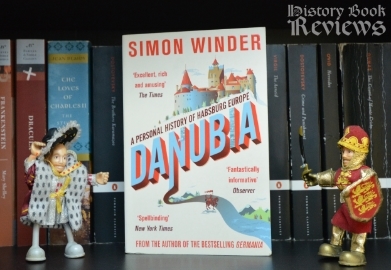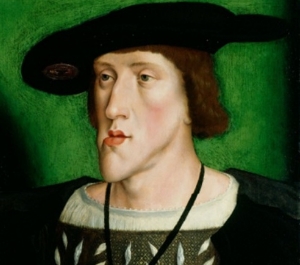Danubia: A Personal History of Habsburg Europe
by Simon Winder

Review
Prepare to fall in love with Habsburg Europe, various late medieval emperors, and basically anything else that Simon Winder talks about! His personal style and sense of humor are so unique and so refreshing that Danubia was nothing short of an absolute, glowing pleasure to read. This book is about the Habsburg dynasty in Central and Eastern Europe, a family that were sometimes emperors, sometimes kings, and sometimes both at once, and their impact on the region of the Danube River from the end of the Middle Ages to the end of World War I. Get ready to meet hilarious and wacky historical characters, virtually tour late medieval castles, and see history through the eyes of a hysterically funny and passionate teacher!
Winder calls his book a "personal history", and that is accurate. This is not a traditional history book in any sense of the word, and Winder openly acknowledges that in the introduction. He tells the reader right from the start that his book is not a comprehensive history and it does not have a unified narrative. Rather, he writes about what he finds personally fascinating after mountains of research and years of travelling throughout every corner of the former Habsburg Empire, opening every Habsburg closet and unveiling every Habsburg skeleton (metaphorically, mostly). It is in large part based on his own personal experiences as a tourist in these places, making the book feel interactive and exploratory. But even though Danubia is not a traditional history, it is hugely informative and educational. The history of Eastern Europe is not well-known in the United States, and there are very few history books about this part of the world published in English. I learned so much new information while reading this book that at times I thought my head would explode!
However, Danubia is not always easy to read. It was actually really difficult to follow at times because of the lack of a cohesive narrative and because Winder jumps around between time periods to make comparisons, often without specifying the date. This book would have been a lot less confusing if I had had a base knowledge of the Habsburgs and Central/Eastern Europe; without one, I often felt lost amidst the swirling tempest of Ferdinands, Fredericks, and Franzs (oh my!). Luckily, the book is so charming and funny that it was enjoyable to read it even when I was struggling to keep up with the characters and the chronology, so I just went along for the ride and worked my way through it (with the saving grace of Wikipedia family trees...).
Winder is witty, sassy, and utterly original. Between calling ancient mummified bodies "priggish", detailing his love for the Guinea Pig Village at the Budapest Zoo (it's exactly what it sounds like), and comparing his children to threatened cats flattening their ears against their heads when he tries to take them to museums, Winder, and Danubia, won my undying affection and admiration, as well as giving me hours of unrivaled entertainment.
Danubia introduces the reader to a flock of historical figures with delightful and often unbelievable eccentricities, figures practically unknown in the West. We meet Emperor Ferdinand I with his prized possession, a narwhal tusk, which he was convinced was a unicorn horn. In the 16th century we encounter Emperor Rudolf II who kept a live dodo bird, a magic mirror made of Aztec obsidian, and a seashell collection. He also had a live lion and tiger that he let roam free in the gardens of Prague Castle. Not surprisingly, these would occasionally maul passing servants, forcing Rudolf to compensate the survivors or their family members. Later we meet Leopold I, who tossed foxes in blankets while hunting to make them easier to catch. Winder really has a gift for bringing the humanity and absurdity of these figures to life, often making fun of them but in a way where you can almost see his affectionate smile as he writes. He is probably also the only author who could make genetic deformity funny. The unfortunate Habsburgs interbred to such an extent that they suffered a whole host of deformities, most notably the infamous 'Habsburg Jaw'. This caused most family members to have a jaw that jutted forward so extremely that their mouths would fill with water every time it rained. Some had it so bad (poor Charles II) that they could barely speak or chew. They also suffered a horrifying infant mortality rate, but I guess that's par for the course when your pet name for your husband is 'Uncle'...and he actually is your uncle.

Emperor Charles V (16th c.) displays the Habsburg Jaw.
The only thing that made this book less than perfect for me was the last few chapters. The book veers away from the people and focuses on geography, on the constantly shifting and evolving borders between all the central European countries and all the tensions and ethnic hatred within them. The countries are discussed by their medieval and their modern boundaries, making it impossible to keep track of whether you're reading about Slavonia, Dalmatia, or Croatia, and if it's an independent kingdom yet or still part of the Austria-Hungary Empire...at any rate, this was a lot less interesting than the rest of the book and I only finished reading because of Winder's amusing anecdotes and obvious passion for this history. If you are fascinated by Central/Eastern European political geography then this book will be a goldmine, but otherwise it will make your eyes glaze over as though you're staring at the portrait Rudolf II commissioned of himself made up entirely of fruits and vegetables.
Ultimately this book has to be on the must-read list, no matter who you are or what your particular interests are. Winder brings the past to life in all its oddities and quirks, and he investigates all aspects of Habsburg life with a curiosity and excitement that happily translate to the reader. My only warning: This book has no pictures, and Winder has a way of describing everything in such a funny and modern way that you will need to see them; I ran out of battery on my phone multiple times a day looking things up online. How could I resist, with descriptions of portraits that make the emperor look like he is on mushrooms? Or the portrait where the emperor is wearing "perhaps the most beautifully designed boots in European history"? (By the way, the boots look like the emperor is standing in flower pots decorated with Christmas bows). So be sure to have a fully charged device or a computer nearby at all times while reading. Danubia is overall a smart, fresh, intelligent history of the Habsburg dynasty that will make you laugh out loud and deeply appreciate your normal-sized jaw.



